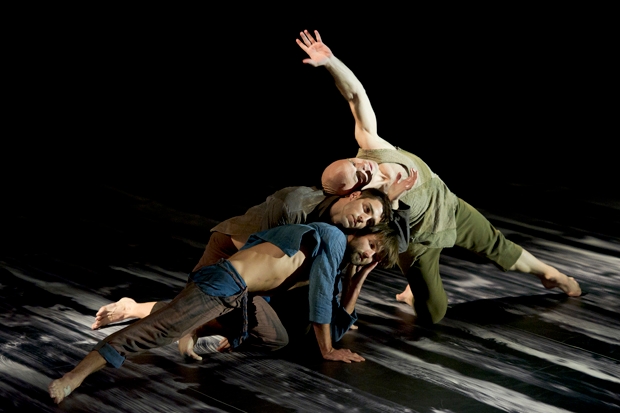Paradoxically, some ballet masterworks absolutely depend on tiptop performing to demonstrate how great they are. If they don’t get it, they can look like the dodgiest of curiosities — did people in those days really rate this stuff? A whole genre of fiercely zipped tragedies of feeling emerged in Britain and the US in the 1930s and 1940s, fed by Antony Tudor, Frederick Ashton and Robert Helpmann over here, and Martha Graham and José Limón over there; works that, unlike classical dance, require acting skills of rare force and perfect pitch. And this genre can be difficult to restage these days, when we tend to react ruthlessly to work that might look like all sobs and no steps.
Limón’s 1949 The Moor’s Pavane has turned up on British stages once or twice, but I have not seen a more convincing showing of the psychological profundity and stylistic genius of this 20-minute distillation of Othello than Birmingham Royal Ballet gave last week on its excellent Shakespeare 400 triple bill.
The work is a tight quartet, a pavane for two couples, Othello and Desdemona v. Iago and Emilia, dressed Tudor-style and set to Purcell, whose sincerity (a score pieced together from The Gordian Knot Untied and Abdelazer Suite) has a perfectly ironic effect here, very English. As in fact Limón choreographed the entire thing without music, and had even considered plopping his creation on to Bartók or Schoenberg, we can’t describe his choreography as musical in that sense. However, it is exceptionally graceful, with its own physical music arising from the stormy emotional phrasing.
The dancers’ courtly formalities and circles are ripped apart by moments of extreme angst, evoking strict Shakespearean etiquette while at the same time pullulating with emotion. And with Tyrone Singleton’s short-tempered, wracked Othello, Delia Mathews’s piercingly innocent Desdemona, Iain Mackay’s insistent, slithery Iago and Elisha Willis investing Emilia with sensuousness and awareness, the 20 minutes encapsulated everything about human dignity and gullibility. Remarkable performing by all four, and I hear that Brandon Lawrence, in the other cast, was equally fine as Othello.
Lawrence and Singleton both attract media inches because they are black, and in this ballet of course racial outsidership is central — Limón himself was Mexican — but apart from that these two guys (from Yorkshire and Surrey) hold the stage with an unselfconscious physical majesty that’s rare to find. Lawrence displayed his unhurried grace in Jessica Lang’s new creation Wink, in which the busy young American choreographer uses lines from five sonnets (spoken in voice-over) to lightly explore a young man/poet’s relationships with women, men and his own writing.
This is manifested in an intelligent, spare modern staging for ten dancers in white or flesh plain costuming, who run between plain white panels (as if in and out of pages from a notebook). There are male solos, females lifted by males, duets and other familiar ballet tropes, all faintly reminiscent of the form of Fokine’s Les Sylphides (another poet dreaming of his muses). A violin solo for the Royal Ballet Sinfonia’s maestro leader Robert Gibbs is the best of Jakub Ciupinski’s score, and Lang’s carefully structured sections climax in a trio in which the poet switches his focus smoothly between a man and a woman. Nice, thoughtful work, but a bit physically pallid in an era after Twyla Tharp’s energetic retooling of contemporary ballet, and it doesn’t partner Shakespeare with any-thing like the surprise that Limón achieved with his audacious pavane.
David Bintley does go for surprises, giggly ones rather than profundities, in The Shakespeare Suite, his 1999 gallop through seven of the Bard’s plays to Duke Ellington and Billy Strayhorn’s smoky jazz Such Sweet Thunder suite of 1956, which brushes up perfectly this year. Costumed with camp relish by Jasper Conran, Hamlet preens narcissistically in shades, Macbeth has punky orange hair and a crazy zebra kilt (rustle the cymbals), and shrewish Kate stamps her baseball-booted feet furiously under her loathed meringue wedding dress.
The clichés come thick and fast, but the highlight is Titania and Bottom as the tiddliest of party guests, heedlessly rutting charleston-style while the clarinet tootles, Laura Purkiss and Kit Holder having a ball in the roles. So does Colin Towns’s Mask Orchestra under Paul Murphy’s vivacious baton.
When Bintley became BRB’s director, to a notable degree he sacrificed his choreographic focus for the demands of directing. This sacrifice was something that Benjamin Millepied quickly decided he would not make when he was appointed director of Paris Opera Ballet 18 months ago. Last spring he resigned his prestigious job to refocus on his own choreography with his Los Angeles-based L.A. Dance Project.
At Sadler’s Wells last weekend, LADP offered a triple bill lavishly sponsored by the jewellers Van Cleef & Arpels — Mr Millepied is married to Natalie Portman — but far from brilliant in dance and dancers. Even more than Jessica Lang’s, Millepied’s mild gift is swamped by dance’s evolutions, still more obliterated by the obvious shadow of Balanchine’s VCA-sponsored masterwork Jewels. Of his two destinies — mediocre choreographer, talented director — Millepied chose the wrong one, I think.






Comments